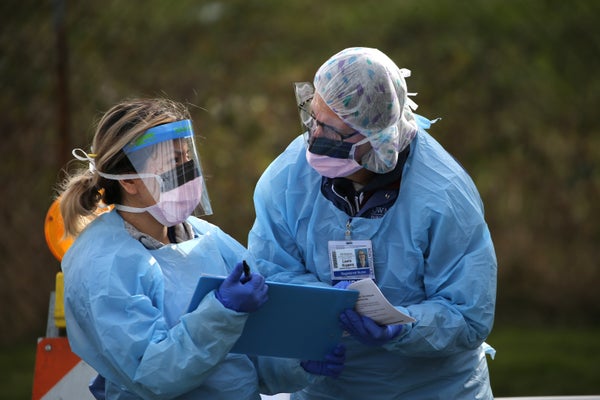This article was published in Scientific American’s former blog network and reflects the views of the author, not necessarily those of Scientific American
The novel coronavirus has touched off another stealthy and growing public health crisis that calls for an equally matched emergency response.
Like other pandemics and emerging disease outbreaks, COVID-19 is creating immense psychosocial disturbances. The disease involves an unfamiliar threat that is difficult to detect and challenging to distinguish from more benign illnesses. Protracted and dynamic pandemic conditions will draw out the anxiety. Things will get worse before they get better. Absent a vaccine, nonpharmaceutical interventions are the only way to prevent infections, and they dramatically upset everyday bodily habits, social interactions and economic exchanges.
Recent grocery store runs are a sign of concern in the community. Personal actions to avoid infection such as stockpiling hand sanitizer also confer a sense of control over an uncertain danger. Improvements to current risk communication can alleviate widespread distress. Top elected officials and health authorities should empathize with people’s fear, normalize stress reactions, provide clear guidance on recommended health behaviors, instruct in concrete protections including those for mental health and share solidarity and resilience messages.
On supporting science journalism
If you're enjoying this article, consider supporting our award-winning journalism by subscribing. By purchasing a subscription you are helping to ensure the future of impactful stories about the discoveries and ideas shaping our world today.
However, more interventions are essential because specific groups are at a higher risk of both acute and lingering emotional distress. Health care workers on the epidemic front lines face compounding stressors: the prospect of more and longer shifts, the need to improvise childcare coverage, finite supplies of personal protective equipment, fear of bringing infection home, witnessing co-workers becoming ill, and making tough allocation decisions about scarce, lifesaving resources like mechanical ventilators.
Exposed individuals confront a potential cascade of challenging circumstances. To protect others, they may enter a state of self-quarantine. During the incubation period, they must live with uncertainty and limit physical contact with others while trying to maintain social connectedness. Derailed income-generating activities and unmet obligations to others can further fuel the stress. Infected individuals may become sick, experience a lengthy convalescence, feel survivor’s guilt, and be shunned despite a complete recovery.
For people with preexisting mental health conditions, a pandemic can further heighten their anxious thoughts and compulsive behaviors. Previously managed symptoms can flare up, requiring additional care beyond what was sufficient precrisis. Disrupted support systems and social isolation can leave people with mental health conditions especially vulnerable to acute stress reactions in an epidemic.
Other groups face distinctive stressors. People who are elderly and people with disabilities are asked to stay out of public and receive fewer visitors; already outside the mainstream bustle of community life, their loneliness may deepen. Asian immigrants and Asian-Americans may experience the sting of stigma and discrimination. Racial and ethnic minority communities with memory of health disparities in past outbreaks may dread similar outcomes in this one. While physically small, children still experience big emotions, and they may lack the skills and development needed to cope with the ongoing crisis.
The need for both universal and targeted mitigation of COVID-19’s psychosocial impacts is arising in the context of a very brittle U.S. mental health system. A parity struggle continues for emotional well-being to secure the same importance, service capacity and financing structures as physical health.There is a shortage of mental health professionals, and many Americans forego help because of cost, stigma and not knowing how to plug in. Such flaws require long-term systemic change. Nevertheless, decision makers, providers and communities can still act now to help alleviate pandemic-induced emotional distress.
Foreground mental health in the response: Allocation decisions for current and future COVID-19 relief funds should include mental health. State and local public health officials should invite their behavioral health authorities to plan the pandemic response together; they can jointly design risk and crisis communication, social distancing protocols and large-scale operations such as drive-through diagnostic testing in ways that promote calm, build resilience and instill hope. Businesses should remind workers of employee assistance programs that then incorporate COVID-19 resources, including virtual ones. Health systems should provide employees the time, place and support staff to help them cope. Neighbors should off-load health care workers’ concerns about childcare and family meals.
Make mental health support obtainable and sustainable: The recently lifted restrictions on Medicare access to telehealth services, including telepsychiatry, are a win. So, too, are moves by some private health insurance providers to waive cost-sharing for telemedicine visits, suspend early medication refill limits, and staff mental health hotlines. More insurers should adopt these measures. Evidence-based mobile apps now supplement in-person provider care and enable people to self-manage their conditions; subscription apps should temporarily suspend or reduce their fees. Practitioners should explore telehealth options, update business continuity plans and temporarily cut out-of-pocket fees.
Deepen the bench of mental health workers:Spiritual leaders of all faiths should ally with behavioral health professionals to develop crisis communication, mutual aid networks and other programming that protects the psyche and spirit of pandemic-affected communities. Volunteer organizations that respond to hurricanes, floods and fires and are expert in disaster mental health should serve as resources during this infectious disease disaster. Lastly, nonexperts should learn psychological first aid (PFA) to help others cope with outbreak-related stress and trauma.
The United States is taking bold moves to counteract the contagion’s physical effects; we must strengthen the country’s resistance to its emotional impacts as well. Just as the infectious disease threat decreases, its psychological reverberations are sure to peak.
This essay was co-authored by:
Elena Martin, MPH, analyst at the Johns Hopkins Center for Health Security, who studies clinical management of high-consequence pathogen infections.
Joshua Morganstein, MD, chair of the Committee on the Psychiatric Dimensions of Disaster at the American Psychiatric Association.
Read more about the coronavirus outbreak here.
